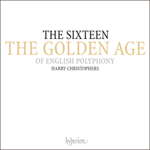
Welcome to Hyperion Records, a British classical label devoted to presenting high-quality recordings of music of all styles and from all periods from the twelfth century to the twenty-first.
Hyperion offers both CDs, and downloads in a number of formats. The site is also available in several languages.
Please use the dropdown buttons to set your preferred options, or use the checkbox to accept the defaults.

The sectional structure of the text: a hymn to the Trinity, a passage in praise of Christ (‘Tu rex gloriae, Christe’), followed by a short antiphon (‘Aeterna fac’) leading into the final section, entails changes of chant, though not of mode, and these changes are of course retained in the polyphonic setting.
The only source of Taverner’s Te Deum is the set of part-books compiled by the Windsor lay clerk John Baldwin and dated 1581, from which the tenor part is missing. The restoration of this part is a fairly straightforward matter since it carries the chant in regular rhythm in every verse except ‘Aeterna fac …’ where the chant migrates to the bass. We may suppose from the extensive use of imitation, as well as the clarity of the part-writing and text-setting, that this is a late work, perhaps composed after Taverner had left Oxford, though whether it was written for a special occasion and what that occasion might have been we cannot now say. Taverner’s mastery of contrapuntal invention is evident in the variety of material he finds to surround the simple chant melody. The full five-voice texture is used throughout, and the scoring is low, which suggests that an adult choir, without boy trebles, was envisaged.
from notes by John Heighway © 2000
La structure des sections du texte: une hymne à la Trinité, un passage à la gloire du Christ («tu rex gloriae, Christe») suivi par une courte antienne («Aeterna fac») qui conduit à la section finale, impose des changements de chant, mais pas de mode, et ces changements sont bien sûr conservés dans la mise en musique polyphonique.
La seule source du Te Deum de Taverner est la série de cahiers séparés compilés par le chantre de Windsor, John Baldwin, datée 1581, auxquels manque la partie de ténor. La reconstitution de cette partie est assez simple puisqu’elle porte le chant en rythme régulier dans chaque strophe à l’exception de «Aeterna fac …» où le chant passe à la basse. Il est permis de supposer, à partir du grand emploi de l’imitation et de la clarté de l’écriture des parties et de la mise en musique du texte, qu’il s’agit d’une œuvre tardive, composée peut-être après que Taverner eut quitté Oxford bien qu’il nous soit impossible de dire si ce morceau a été écrit pour une occasion spéciale et quelle était cette occasion. La maîtrise de l’invention contrapuntique de Taverner est évidente par la variété de matériel qu’il trouve pour entourer la simple mélodie du chant. Il utilise la texture à cinq voix du commencement jusqu’à la fin et la mise en partition est basse ce qui laisse penser qu’il envisageait un chœur de chanteurs adultes sans voix hautes de jeunes garçons.
extrait des notes rédigées par John Heighway © 2000
Français: Martine Erussard
Der Satzaufbau des Worttextes, ein Hymnnus an die Trinität, eine Passage zum Lobe Christi („Tu rex gloriae, Christe“), gefolgt von einer kurzen Antiphon („Aeterna fac“), die in den letzten Abschnitt überleitet, bringt Änderungen im Gesang, jedoch nicht in der Tonart mit sich, die selbstverständlich in der polyphonen Vertonung beibehalten wurden.
Die einzige Quelle zum Te Deum Taverners sind die vom Laiengeistlichen John Baldwin in Windsor zusammengestellten Stimmbücher, die mit 1581 datiert sind und in denen die Tenorstimme fehlt. Der Wiedereinsatz dieser Stimme ist eine ziemlich einfache Angelegenheit, da diese den Cantus in allen Versen ausser dem „Aeterna fac …“, wo er in die Bassstimme wandert, in regelmässigen Rhythmen trägt. Wir können aufgrund der ausgiebigen Anwendung von Imitation sowie aufgrund der Klarheit der polyphonen Schreibweise und Textvertonung davon ausgehen, dass es sich um ein Spätwerk handelt, das Taverner vielleicht im Anschluss an seine Oxforder Zeit komponiert hatte. Ob es nun für einen speziellen Anlass und für welchen geschrieben wurde, mussallerdings dahin gestellt bleiben. Taverners kontrapunktischer Einfallsreichtum tritt meisterhaft in der Vielfalt des Materials in Erscheinung, mit dem er einen einfachen Cantus umrahmt. Die volle Fünfstimmigkeit findet durchweg ihren Einsatz und ist das Register ist tief, was darauf schliessen lässt, dass es für einen Erwachsenenchor ohne Knabenstimmen vorgesehen war.
aus dem Begleittext von John Heighway © 2000
Deutsch: Eike Hibbett
 The Sixteen & The Golden Age of English Polyphony The Sixteen & The Golden Age of English PolyphonyWhen The Sixteen embarked upon their recording career back in 1982, few would have been able to predict quite how far they would go towards rehabilitating the little-known music of these four master composers of the 16th century. In this their 30t ...» More |

